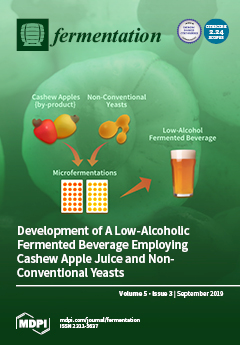(1) Background: It has been shown that
d-galacturonic acid is converted to
l-galactonic acid by the basidiomycotic yeast,
Cryptococcus diffluens. However, two pathways are hypothesized for the
l-galactonic acid conversion process in
C. diffluens. One is similar to
[...] Read more.
(1) Background: It has been shown that
d-galacturonic acid is converted to
l-galactonic acid by the basidiomycotic yeast,
Cryptococcus diffluens. However, two pathways are hypothesized for the
l-galactonic acid conversion process in
C. diffluens. One is similar to the conversion process of the filamentous fungi in
d-galacturonic acid metabolism and another is the conversion process to
l-ascorbic acid, reported in the related yeast,
C. laurentii. It is necessary to determine which, if either, process occurs in
C. diffluens in order to produce novel value-added products from
d-galacturonic acid using yeast strains. (2) Methods: The diethylaminoethy (DEAE)-fractionated enzyme was prepared from the cell-free extract of
C. diffluens by the DEAE column chromatography. The
l-galactonic acid conversion activity was assayed using DEAE-fractionated enzyme and the converted product was detected and fractionated by high-performance anion-exchange chromatography. Then, the molecular structure was identified by nuclear magnetic resonance analysis. (3) Results: The product showed similar chemical properties to 2-keto-3-deoxy-
l-galactonic acid (
l-threo-3-deoxy-hexulosonic acid). (4) Conclusions: It is suggested that
l-galactonic acid is converted to 2-keto-3-deoxy-
l-galactonic acid by dehydratase in
C. diffluens. The
l-galactonic acid conversion process of
C. diffluens is a prioritized pathway, similar to the pathway of ascomycetes.
Full article





